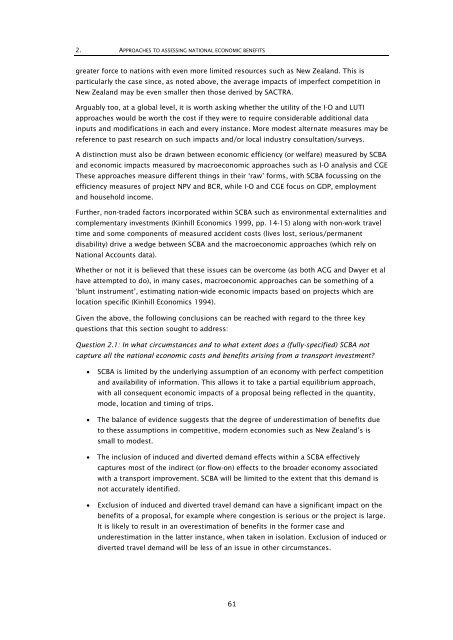Research 350 - NZ Transport Agency
Research 350 - NZ Transport Agency
Research 350 - NZ Transport Agency
You also want an ePaper? Increase the reach of your titles
YUMPU automatically turns print PDFs into web optimized ePapers that Google loves.
2. APPROACHES TO ASSESSING NATIONAL ECONOMIC BENEFITS<br />
greater force to nations with even more limited resources such as New Zealand. This is<br />
particularly the case since, as noted above, the average impacts of imperfect competition in<br />
New Zealand may be even smaller then those derived by SACTRA.<br />
Arguably too, at a global level, it is worth asking whether the utility of the I-O and LUTI<br />
approaches would be worth the cost if they were to require considerable additional data<br />
inputs and modifications in each and every instance. More modest alternate measures may be<br />
reference to past research on such impacts and/or local industry consultation/surveys.<br />
A distinction must also be drawn between economic efficiency (or welfare) measured by SCBA<br />
and economic impacts measured by macroeconomic approaches such as I-O analysis and CGE<br />
These approaches measure different things in their ‘raw’ forms, with SCBA focussing on the<br />
efficiency measures of project NPV and BCR, while I-O and CGE focus on GDP, employment<br />
and household income.<br />
Further, non-traded factors incorporated within SCBA such as environmental externalities and<br />
complementary investments (Kinhill Economics 1999, pp. 14-15) along with non-work travel<br />
time and some components of measured accident costs (lives lost, serious/permanent<br />
disability) drive a wedge between SCBA and the macroeconomic approaches (which rely on<br />
National Accounts data).<br />
Whether or not it is believed that these issues can be overcome (as both ACG and Dwyer et al<br />
have attempted to do), in many cases, macroeconomic approaches can be something of a<br />
‘blunt instrument’, estimating nation-wide economic impacts based on projects which are<br />
location specific (Kinhill Economics 1994).<br />
Given the above, the following conclusions can be reached with regard to the three key<br />
questions that this section sought to address:<br />
Question 2.1: In what circumstances and to what extent does a (fully-specified) SCBA not<br />
capture all the national economic costs and benefits arising from a transport investment?<br />
• SCBA is limited by the underlying assumption of an economy with perfect competition<br />
and availability of information. This allows it to take a partial equilibrium approach,<br />
with all consequent economic impacts of a proposal being reflected in the quantity,<br />
mode, location and timing of trips.<br />
• The balance of evidence suggests that the degree of underestimation of benefits due<br />
to these assumptions in competitive, modern economies such as New Zealand’s is<br />
small to modest.<br />
• The inclusion of induced and diverted demand effects within a SCBA effectively<br />
captures most of the indirect (or flow-on) effects to the broader economy associated<br />
with a transport improvement. SCBA will be limited to the extent that this demand is<br />
not accurately identified.<br />
• Exclusion of induced and diverted travel demand can have a significant impact on the<br />
benefits of a proposal, for example where congestion is serious or the project is large.<br />
It is likely to result in an overestimation of benefits in the former case and<br />
underestimation in the latter instance, when taken in isolation. Exclusion of induced or<br />
diverted travel demand will be less of an issue in other circumstances.<br />
61
















